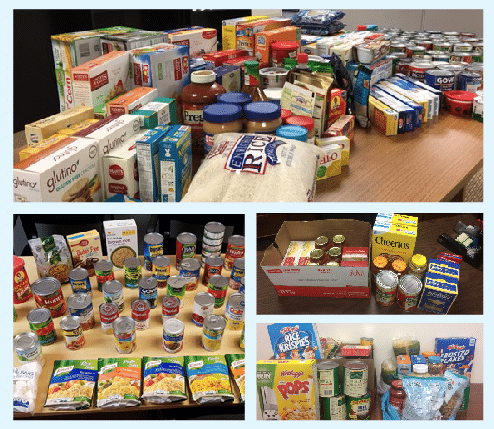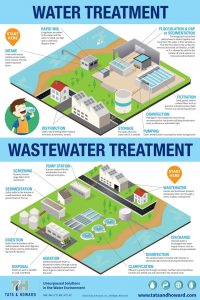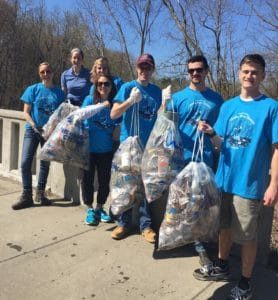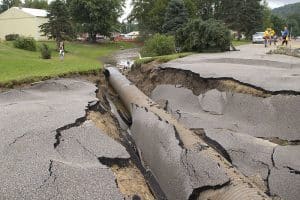T&H employee-owners enjoyed the annual Thanksgiving Luncheon on Tuesday, November 22, and as always, it was a big success. Employee-owners were encouraged to bring in their favorite foods and take some time to appreciate the holiday season. In addition, we were lucky to have some fellow employee-owners from our satellite offices to join us for the food and fun. For our six newest engineers, it was a memorable first Thanksgiving celebration at T&H. There was great food, great people, and a lot of laughs.


Month: November 2016
Thanksgiving Food Drive 2016
Tata & Howard’s annual Thanksgiving food drive is always a big success, and 2016 was no exception. Our company goal was to donate at least 350 pounds of food, and we ended up collecting and donating 451 pounds of food to local food banks and pantries. In addition, a friendly interoffice competition took place where the office that donated the highest number of pounds of food per person would win. Congratulations to the Portland, Maine office that won the team competition by donating over 18 pounds of food per person!

Giving Thanks – for Water!
 It is widely known how important water is to our lives and the world we live in. Our body and planet is comprised of about 70% water – making it seem like it is easily accessible and plentiful. However, when you rule out our oceans and ice caps, less than 1% of all the water on Earth is drinkable. Of that less than 1%, groundwater only accounts for 0.28% of fresh water around the globe. Safe drinking water is a privilege we often take for granted while we brush our teeth or drink a glass of water in the morning. While we are giving thanks to our family, friends, and food during Thanksgiving, we should also give big thanks for our clean drinking water and the people who make it happen.
It is widely known how important water is to our lives and the world we live in. Our body and planet is comprised of about 70% water – making it seem like it is easily accessible and plentiful. However, when you rule out our oceans and ice caps, less than 1% of all the water on Earth is drinkable. Of that less than 1%, groundwater only accounts for 0.28% of fresh water around the globe. Safe drinking water is a privilege we often take for granted while we brush our teeth or drink a glass of water in the morning. While we are giving thanks to our family, friends, and food during Thanksgiving, we should also give big thanks for our clean drinking water and the people who make it happen.
The Importance of Clean Water

Keeping yourself hydrated can do wonders for your health. The benefits water provides for our bodies range from relieving headaches, flushing toxins out of the body, improving mood, helping with weight loss, and relieving fatigue. In the U.S., we are fortunate enough to have some of the cleanest drinking water anywhere in the world to keep us healthy and safe. In other countries and for some 783 million people, that is not the case. Many do not have access to sufficient drinking water and the water they do have often contains dangerous pathogens. Often, unclean water sources are miles from villages and some people are forced to spend hours each day simply finding and transporting water. The typical container used for water collection could weigh between 40 and 70 pounds when filled. Imagine how difficult it would be to carry the equivalent of a 5-year-old child for three hours out of each day just to have water to drink. With so many people not having access to clean drinking water around the world, it is important to appreciate the plentiful and safe drinking water we have here in America.

A Special Thanks for the People Who Make Our Water Safe
When looking at America’s clean water, it is especially important to give special thanks to the water and wastewater utilities that work nonstop to give us some of the cleanest drinking water in the world. Despite the fact that our country has beautiful rivers and lakes, the water that comes from them to our taps goes through several processes that require a lot of work and maintenance. Our water and wastewater utilities maintain some of the highest standards in the world when it comes to drinking water, and new innovations for treatment and distribution are always being researched and implemented. Water and wastewater employees work tirelessly to meet regulatory requirements and preserve local waterways despite major setbacks like deteriorating infrastructure and shrinking funding for necessary projects. On top of treating our water, utilities are responsible for keeping their distribution systems running efficiently and also to being stewards to the environment through improving effluent quality. Our water utilities are arguably the most important utilities in the nation because water is so crucial to our survival.
In Conclusion
We are so incredibly fortunate here in the United States to not have to think twice about the purity of water from the tap, a glass of water in a restaurant, a highway rest stop, an airport, or motel – all thanks to our water and wastewater utilities. For that, we should be especially thankful. This Thanksgiving, be sure to give special thanks for having safe drinking water and to the dedicated, hard-working people at water and wastewater utilities.
National Philanthropy Day 2016 – Building a Culture of Philanthropy

Corporate philanthropy has changed dramatically over the past decade. First and foremost, millennials have entered the workforce in droves, and they play a major part in company influence. While Generation X and Baby Boomers tend to make a clear delineation between work and life, millennials maintain fluidity in all aspects of their lives and expect far more out of their employers. Therefore, employee engagement has become paramount to the success of today’s companies, and one of the best ways to foster employee engagement is through a culture of philanthropy.
Building a culture of philanthropy requires a concerted effort from senior management and human resources. Gone are the days of holding an annual food drive at Thanksgiving or toy drive during the holiday season. Today, year-round involvement in charitable ventures and the community is almost expected, through both volunteerism and financial commitment. National Philanthropy Day, which falls on November 15, is an exemplary time for corporations to truly examine their philanthropic culture – or lack thereof.
Where to Start?
Creating an authentic culture of philanthropy requires three key ingredients. First and foremost, leadership involvement is essential. Employees, particularly millennials, know when an employer is fully committed and when they are just going through the motions. A true culture of philanthropy requires both buy-in and participation from leadership.
Second, workplace giving programs and volunteerism should be an integral part of a company’s corporate identity – which again comes down to support from leadership. Because culture always trickles down from the top, involvement from leadership is an absolute requirement. While a company can say that giving of money and time are important, senior management’s actual participation in a company’s charitable ventures provides authenticity through leading by example. Without leadership involvement, employee engagement programs will appear superficial and perfunctory and are likely to fail.

Third, charitable programs must align with both employee interests and corporate goals. For example, Gardener’s Supply Company in Vermont is a retail and online gardening supply company that offers everything from seedstarting supplies and garden furniture to flower supports and garden carts. Like Tata & Howard, they are also 100% employee-owned. In 2013, a group of employees at the Burlington location started Company Farm. Their goal was to grow potatoes to donate to people in need. In the first year alone, employee-farmers grew over 300 pounds of potatoes on a set of thirty 4×6-foot raised beds just off the company’s main parking lot. All of these potatoes were donated to support need in the local community, and Gardener’s Supply plans to increase their output as well as encourage other companies to also turn some of their lawns into farms.
How to Get Involved
A culture of philanthropy is not just for large companies – small-to-mid-size companies are becoming increasingly involved as more and more millennials enter the workforce. While larger companies are able to support a variety of charitable ventures, smaller companies need to be more strategic in their philanthropy. Several ways in which companies of all sizes are fostering an engaged workforce include providing paid time off specifically for volunteerism, 100% company matches on all employee donations to 501(c)3 organizations, and company-sponsored charitable events and initiatives that align with the company’s mission, vision, and values. At the core of a true culture of philanthropy is the encouragement and participation at all levels within an organization to give their time, money, and talent.

At Tata & Howard, we are passionate about clean water, so we have forged a partnership with Water For People, a non-profit whose mission is to promote the development of high quality drinking water and sanitation services, accessible to all, and sustained by strong communities, businesses, and governments. Water For People is our charity of choice, and employee-owners are able to donate directly to the organization through payroll deductions, which the company matches 100%. In addition, Tata & Howard employee-owners participate in other charitable events that complement our corporate philosophy, including river clean-ups, cancer research fundraising, food drives, and the Navajo Water Project, to name a few. Supporting charitable organizations and events that have a direct tie to a company and to its employees is key to true employee engagement.
Looking Ahead
Because of the changing face of our workforce, building a culture of philanthropy is no longer considered either incidental or superfluous. In fact, the most engaged companies have substantial and clear policies in place that support philanthropic ventures at all levels within their organizations. And the payoff is clear: reduced attrition, greater productivity, higher profits, and also a positive team environment that makes the world a kinder, gentler place.
Care to share? We’d love to hear how your company celebrates National Philanthropy Day and promotes a culture of philanthropy!
Election 2016 – Vote to Invest in Infrastructure
This year’s presidential campaign trail has been unique. The two leading candidates challenge convention in numerous ways, and have fostered one of the most heated election years in decades. While many issues and facts have fueled both the passion and the divisiveness of this year’s presidential election, there is one issue on which all parties agree: the urgent need to invest in infrastructure.
Out of Sight, Out of Mind

Because our nation’s water and wastewater infrastructure is buried underground, it is often forgotten. After all, safe, clean drinking water is ours at the turn of the tap, and wastewater disappears instantly with the flush of a toilet. This buried infrastructure is one of the key components of modern-day civilization, without which our society would cease to function properly – if at all.
Alarmingly, our national water and wastewater infrastructure is in desperate need of upgrading. The ASCE 2013 Report Card for America’s Infrastructure gives our water and wastewater infrastructure a D grade, and the EPA notes that about 30% of large system pipes are 40-80 years old, and another 10% are over 80 years old. In the northeast, this statistic only goes up, with some pipes being well over 100 years old. Our nation’s infrastructure is arguably reaching the end of its useful life. Currently, we lose about seven billion gallons of clean, treated drinking water every single day from leaky pipes, which is enough water to supply the daily needs of the entire state of California. Considering that many communities, including the State of California, have been under drought watch for years, this water loss is deeply concerning.
In addition to our nation’s crumbling water infrastructure, many of our nation’s water service lines are made of lead. To avoid catastrophes like the Flint, Michigan lead crisis earlier this year, the lead service lines that are still supplying seven to ten million American homes need replacement. Also, many of our nation’s wastewater treatment plants were constructed following the passage of the Clean Water Act in 1974, and they are now 30-40 years old and very much in need of rehabilitation or replacement.
Where the Presidential Candidates Stand on Infrastructure

To improve our water and wastewater systems before they reach failure, it is imperative that our elected leaders push for legislation to invest in infrastructure. Yet because our nation has so many other pressing issues and needs, our buried infrastructure is often overlooked. However, in the wake of this year’s Flint, Michigan lead crisis, our nation’s water and wastewater infrastructure has come to the forefront of the minds of American citizens and legislators, with some funding and improvement already being implemented. It is crucial that we elect leaders who will continue this momentum.
At the presidential level, both candidates have promised increased funding for our buried infrastructure. Democratic candidate Hillary Clinton has proposed a plan which includes spending $250 billion over the next five years on all types of infrastructure, including not only water and wastewater systems but also roads and bridges, broadband, passenger rail systems, airports, levees, and dams. In addition, her plan includes $25 billion in seed money to establish a National Infrastructure Bank, which would provide funding for local infrastructure projects. She has said that the bulk of her $275 billion plan would be funded by business tax reforms.
Republican candidate Donald Trump has proposed a decade-long, $1 trillion plan that was drafted by economic advisors Peter Navarro and Wilbur Ross. Unlike Clinton’s plan which depends on additional taxes, Trump’s plan relies heavily on private funding and tax credits for investment. Trump’s belief is that taxes collected from laborers and from companies working on these projects would offset any costs incurred by the government in the form of tax credits to investors. In addition, projects that receive tax credits would be required to have a dedicated source of revenue, such as tolls for roads or water bills for utilities, that would guarantee a source of cash flow back to investors and better attract private investment.
Voting for the Future of our Nation

Besides the presidential candidates, there are numerous elections for Senate and Congressional seats that will play a key role in the future of our nation’s infrastructure. Because the president is only as effective as the Senate and Congress that support him or her, it is critical that we as a nation elect legislators who will champion plans of action and funding to rehabilitate and replace our nation’s buried infrastructure both now and in the future. Whether the investment comes from taxpayers, private investors, or a combination of the two, the fact remains that the clock is ticking on our nation’s water and wastewater infrastructure and the time to invest in infrastructure is now. Happy voting!
Unidirectional Flushing Programs – A Yearly History Lesson Whitepaper
ABSTRACT: A unidirectional flushing (UDF) program when properly performed can provide a unique chronological account of flow through the distribution system. While a UDF program cleans the loose debris from individual mains, it also identifies closed and/or malfunctioning valves and provides data relative to pipe friction factors. Performed year after year, a UDF program can identify the effect of recent system improvements or deterioration through comparison of annual data.
